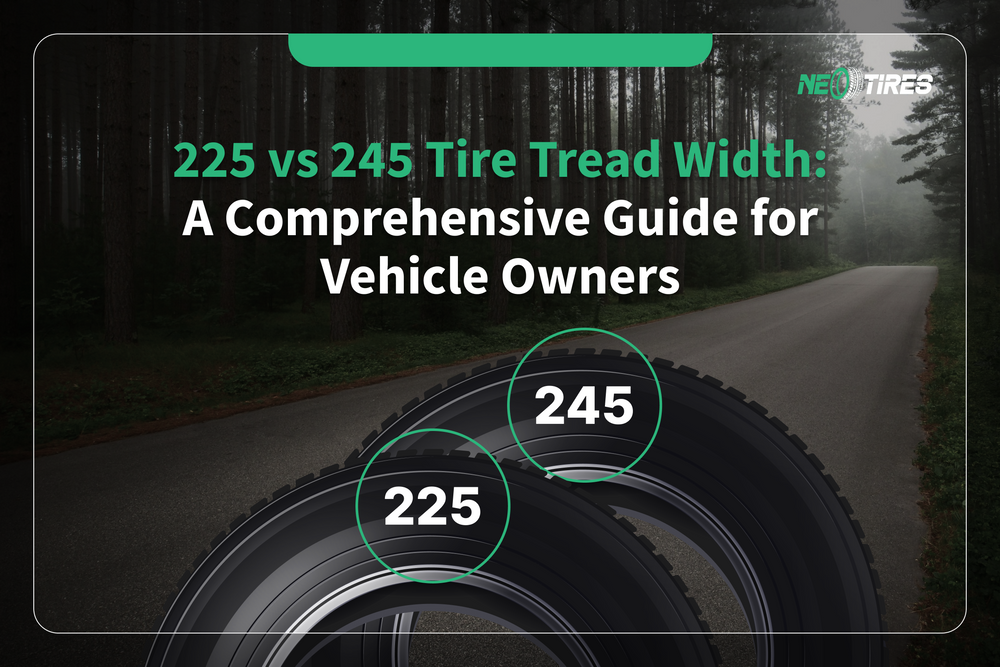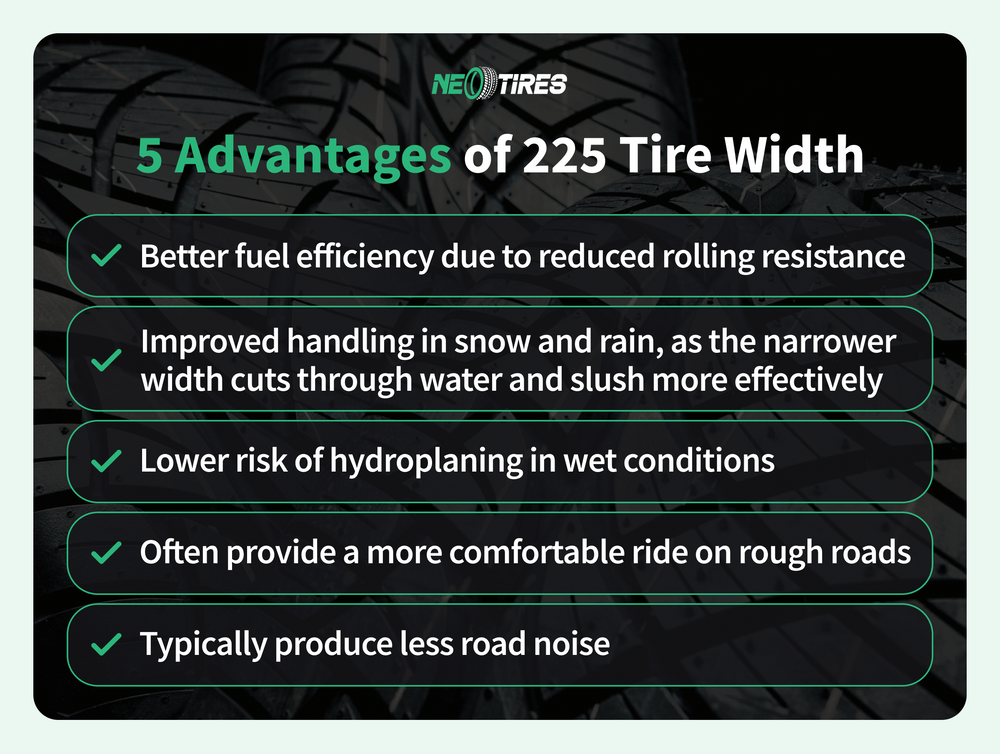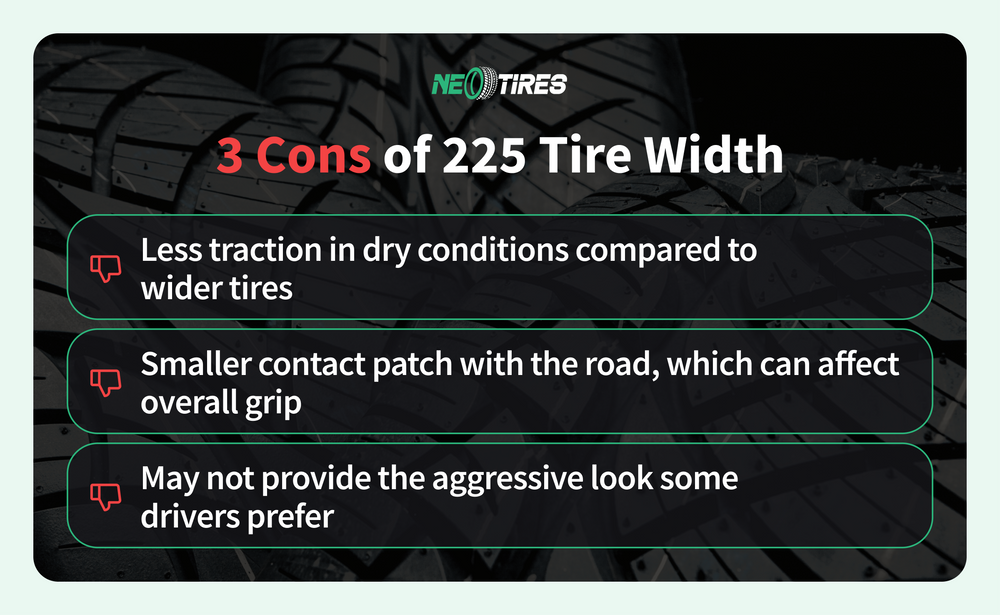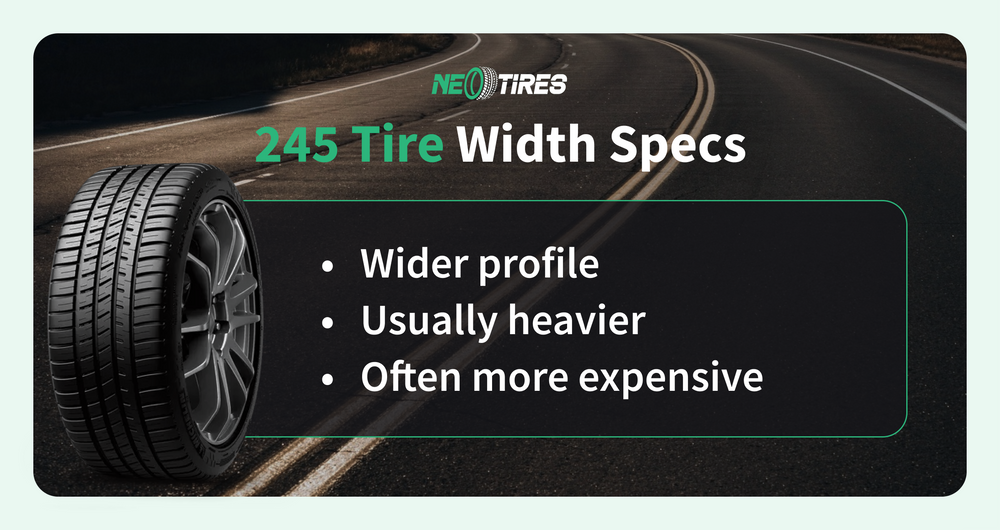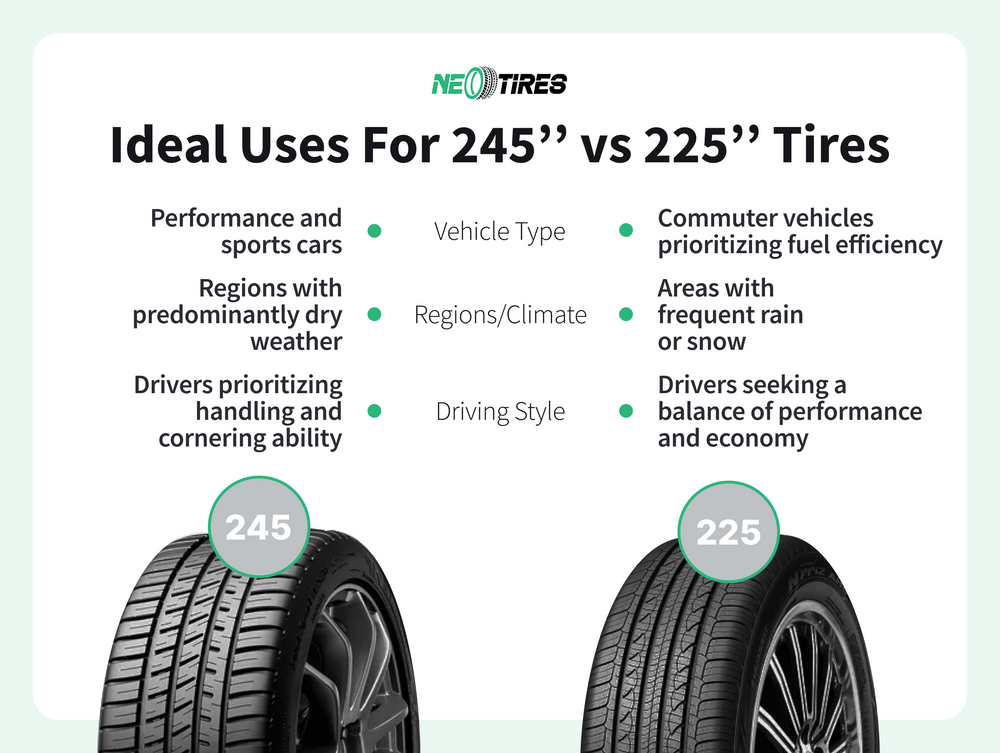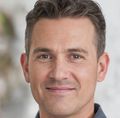The tire tread width plays an important role in tire construction as it influences vehicle safety, handling, and overall performance. The tread width has to deal with tire water displacement properties, traction and grip, and vehicle load distribution. When choosing tires, it's essential to consider your specific driving needs, vehicle type, and typical road conditions to select the most appropriate tread width. Today, we will focus primarily on 225 and 245 tire tread widths.
225 Tire Tread Width
The 225-mm tire tread width is the measurement in mm from one sidewall to the other. It is common for smaller-performance cars, sedans, and compact SUVs. Not excessively wide, a 225-mm tire delivers balanced road contact, decent fuel efficiency, and grip. It is commonly usable for daily commuting and light-performance driving.
225 Tire Width Characteristics
A tire featuring 225 mm width is typically a 15-17-inch tire with a load capacity ranging between 2,000-3,500 pounds. Usually lacking excessive specialized features, a 225 tire provides reasonable fuel efficiency, all-season versatility, and reliable performance for everyday passenger vehicles.
5 Advantages of 225 Tire Width
The 225 tires deliver at least five advantages: reasonable fuel efficiency, decent snow handling (due to their narrow width and cutting-through properties), reliable hydroplaning control, fair noise control, and decent comfort.
3 Disadvantages of 225 Tire Width
The 225-width tires provide less traction in dry conditions than wider tires because they have fewer contact patches with the road. This compromises the overall grip, especially in sharp cornering and high-speed driving. 225-width tires are usually seen as less aesthetically appealing than their wider counterparts, even if this is a subjective opinion.
225 Tires: When To Use
The 225 tires are a good option for drivers using sedans and compact SUVs, driving mainly in areas with frequent rain and light snow. Also, 225 tire width is a good option for drivers seeking a balance between fuel economy and decent performance.
245 Tire Tread Width
A 245-mm tire tread width refers to the width of a tire measured 245 mm from one sidewall to the other. This width is commonly found on SUVs, large sedans, and performance vehicles. A tire with a 245-mm tread width typically provides a larger contact patch (compared to 225-mm tires), which translates into improved handling, better traction, and higher stability in assertive driving.
245 Tire Width Characteristics
A 245-width tire delivers superior road contact, dependable traction, and enhanced cornering stability for full-size SUVs, performance sedans, and sports cars. These tires have a higher load capacity between 3,500 and 4,500 pounds and are generally compatible with 17-19'' rims. While not the most fuel-efficient, 245 tires provide high-speed balance and excellent grip and responsiveness.
5 Advantages of 245 Tire Width
The 245" tires allow for superior traction due to a wider contact patch, especially in dry conditions. This tire width provides dependable stability in sharp cornering maneuvers, even at high speed. 245-width tires deliver agile and short braking properties. They look appealing and greatly support the demands of sports-oriented vehicles.
4 Disadvantages of 245 Tire Width
Due to their increased rolling resistance, 245-width tires are generally less fuel-efficient. The buoyancy forces slightly compromise hydroplaning control. Additionally, because of their larger surface area, 245-width tires deliver harsher rides, especially on rough terrain, and transmit more noise into the cabin.
245 Tires: When To Use
The 245 tires are suitable for drivers owning sports and performance cars. 245 tire width is optimal for areas with predominantly dry climates. 245 tires are to be used when the main driver's goal is increased traction, sporty performance, high cornering stability, and precise handling.
Comparing Performance: 225 vs 245
225 vs 245 Handling and Stability
245 tires generally deliver better handling in dry conditions. The reason is the wider contact patch and, hence, firmer stability. On the other hand, handling in wet and slushy conditions is generally better with 225" tires due to their cut-through-water properties. Still, tire handling properties in wet/dry conditions also depend on the manufacturers' specific technologies.
225 vs 245 Traction
The 245 tires deliver better traction in dry conditions, while the 225 tires do a great job in wet ones. Please consider that specific manufacturers' techniques and design strategies might influence the traction of 225 and 245 tires in specific conditions.
225 vs 245 Comfort and Noise
The 225 tires generally deliver higher levels of comfort and better suppress road noise. While comfort and noise seem to be more of a disadvantage for the 245 tires, these compensate with better stability, especially at high speeds. Manufacturers' technologies influence the noise and comfort levels of each particular tire.
225 vs 245 Fuel Efficiency
245 tires usually consume more fuel because of their higher rolling resistance.
225 vs 245 Aesthetics
245 tires typically feature a more aggressive look. While it's a strictly subjective standpoint, 245'' products deliver higher aesthetic appeal compared to the 225 ones.
225 and 245 Tires: How To Choose
The following seven factors should be taken into account when deciding which tire width is worth the shot between 225 and 245:
225 vs 245 Tires: Driving Conditions
Drivers living in wet and snowy areas should consider 225 tires. Conversely, 245 tires comfort better drivers of performance-dedicated vehicles. Modern technologies allow premium manufacturers to create reliable tires regardless of width. It is important to evaluate the manufacturer and the techniques he uses in his products so that they perform firmly regardless of width.
225 vs 245 Tires: Performance Preferences
We recommend determining your priorities before choosing between 225 and 245 tires. Consider fuel efficiency, the sporty nature you seek, comfort, and handling.
225 vs 245 Tires: Budget Constraints
Take into account the available budget for short—and long-term tire maintenance. 245 tires are generally more expensive. Their higher rolling resistance makes them more expensive to exploit.
Conclusion
Both width options are helpful whenever they are chosen the right way. We recommend that you make the choice based on the specifics of your vehicle, your preferences, and the conditions in which you mainly drive. Thus, you can avoid the potential side effects of any of the two widths.
An informed decision will enhance your driving experience and ensure optimal performance. Please be sure to look for professional help if any doubts arise to find the perfect fit for your vehicle. Our qualified team is ready to consult you if you don't know where to start.
Find Your Ideal Tire Width with NeoTires
Knowing the difference between 225 and 245 tires is essential for making informed decisions about buying new tires. At NeoTires, we offer both options from trusted brands at affordable prices.
We can help you find the exact tire dimensions and upgrade to the convenient tire width for your driving style and vehicle requirements. Contact us for professional guidance, or explore our tire selection to find the best fit!
Why Trust Us
NeoTires experts focus on providing unbiased tire-related information and ratings. We focus on data-driven methodologies without being influenced in any way by manufacturers or advertising purposes. Our evaluation process of the products and information offered is based on the following pillars:
- independent testing of various products in real-world conditions;
- validation of data, information, and tips through quantifiable performance metrics;
- improvement of tire-related knowledge through industry training;
This 225 vs. 245 tire width article is an objective analysis derived from our own observations combined with those of reputable manufacturers and industry experts, such as Bridgestone, Continental, and Consumer Reports. Drive safe and choose your tires wisely!




